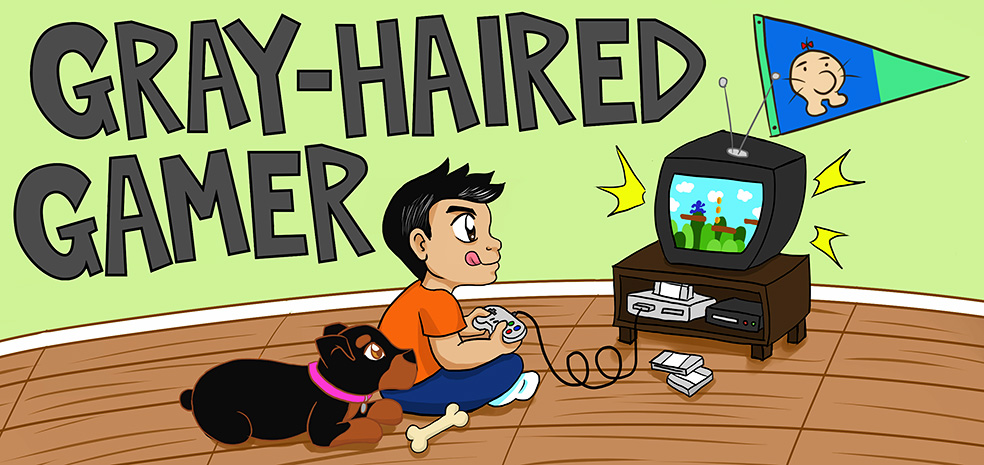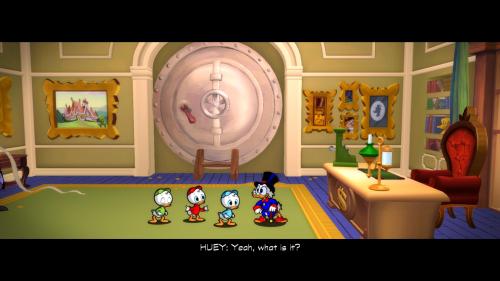D-d-d-danger! Watch behind you!
There’s a stranger out to find you!
What to do? Just grab on to some
DuckTales! A-woo-oo!
If ever there was a late-’80s earworm, the DuckTales theme song is it. It’s impossible to look at that iconic logo and not start singing along. DuckTales came out back when I was in junior high. It was a time when my friends and I suddenly got too old — and in our minds, too cool — for Saturday morning cartoons. Shows like Robotech were drawing us away from the cheap, mindless fare that was common back then, but DuckTales was different. It looked terrific, and had exceptional, fluid animation. I loved it, and whether I’m right about this or not, I always credited its quality and success in part for the resurgence of Disney’s animated theatrical releases shortly thereafter with The Little Mermaid and the lesser-known and under-appreciated Rescuers Down Under.
 Its popularity led to the Capcom classic game of the same name on the NES in 1989, which GHG reviewed last month. Despite its short length, simple boss battles, and pogo-jump controls that are arguably a little too complex, I really enjoyed it, and consider it a very solid 8-bit title, particularly when you take into consideration that it’s licensed, and could have been bad. Very bad.
Its popularity led to the Capcom classic game of the same name on the NES in 1989, which GHG reviewed last month. Despite its short length, simple boss battles, and pogo-jump controls that are arguably a little too complex, I really enjoyed it, and consider it a very solid 8-bit title, particularly when you take into consideration that it’s licensed, and could have been bad. Very bad.
When it was revealed that WayForward Technologies — a company known for their skill at crafting retro-style action games like Contra 4 and the excellent Shantae: Risky’s Revenge — was developing an HD remastered version of DuckTales, excitement levels went through the roof. I mean, if it’s not going to be Capcom themselves, who better to do it than a company that specializes in this sort of thing? While the selfish side of me was kinda hoping for Inti Creates instead, I put my faith in WayForward that they’d deliver. And for the most part, they did.
First of all, full disclosure here: I played through DuckTales Remastered on its default difficulty first, which is set to Easy. I do this for all games, since it’s my belief that the default setting is what the developers want the majority of players to experience, and most play balance and tweaking generally center around it during testing. More on this later, but it’s an important detail to note.
Graphically, DuckTales Remastered does a lot of things right. The character art in particular is fantastic, with silky-smooth and expressive animation cycles that really bring them to life. WayForward did a phenomenal job ensuring that everyone looks as good as we remember from childhood, with new cameos that will surprise those intimately familiar with the NES original. Enemy art and animation are just as impressive, and it was so nice to see the same high quality level of effort go into both basic enemies and major bosses.
I found the backgrounds to be OK, but there was nothing there that really blew me away. They are full of nice colors and provide a good amount of depth and separation, but they lack detail and most of them just looked overly simplistic to me and at odds with the quality of the superb 2D elements. Throw in generic-looking environmental objects that have a floaty, pasted-on look, and you end up with an overall visual aesthetic that didn’t really work for me. It gets the job done, but there was just something about the look of the game that never quite felt right, and I couldn’t help but ask myself, “How much better would this have been had it all been in 2D?”
DuckTales Remastered‘s soundtrack, however, is tremendous. Composed by Jake Kaufman — who has also scored a number of other WayForward games and the amazing Shovel Knight — this is an updated soundtrack done right. All of your favorites from the NES game are here, with a perfect balance of modern instrumentation, extended arrangements of classic melodies, and beautiful retro nods that pay nothing but the utmost of respect to the source material. Hats off to Kaufman for his great work here, and I highly recommend a purchase of it on Amazon or iTunes.
The game also contains full voice acting, which is all delivered by the talented voice actors from the original show, giving DuckTales Remastered an even more authentic feel. Unfortunately, little restraint was exercised when it came to the sheer amount of dialogue here. Perhaps it was excitement about having the original cast involved, but it’s completely overdone and takes the player out of gameplay for far too long. You can’t speed it up and the only way to skip it is via the pause menu. It really kills pacing and could have easily been cut in half. As it stands, it’s full of needless exposition that is cool at first, but doesn’t take long for it to become borderline insufferable.
Gameplay-wise, DuckTales Remastered is a little bit of the old, a little bit of the new. It controls well enough, and the gameplay is as you remember, with Uncle Scrooge able to use his cane to pogo-jump around levels, find hidden treasure, discover secret areas, and use rocks and objects to take out enemies, just like the NES game. Speaking of the pogo-jump, you can now do it just by jumping and pressing the action button instead of having to press down on the d-pad as well. WayForward has both control options available, though, so go with what you’re most comfortable with. I used the default (i.e., easier) way, and I thought it was great.
There is also a new collectibles objective where you have to find various objects around each stage to progress, but there’s no mystery to their whereabouts since they’re all marked on the pause menu map. It switches up the way you have to play the game in that it forces you to do these things before taking on the level’s boss, which is a fundamental change from how the original DuckTales worked.
These were likely added to enrich the game’s storyline and extend overall play time, and although they feel a bit contrived in that sense, I didn’t mind their addition.
Getting back to what I said earlier about playing on the game’s default difficulty, I got through the game in about 3 hours. Although I didn’t die during any of the boss fights — which are more fun than the NES game’s, but still very predictable — I died quite a few times during regular gameplay, usually falling into a bottomless pit or some other instant-death scenario. You have unlimited lives, and I didn’t think anything of this. That’s modern game design 101, and most games don’t penalize you at all except for maybe sending you back to the last checkpoint. That’s what DuckTales Remastered does. On Easy.
On other difficulties, your lives are now limited. Losing them means Game Over, but it also means you lose everything from that level and you have to start over from scratch. This is utterly crazy. I would expect to at least keep found treasures and overall progress. If I have to start over from the beginning? Fine. I’ll make my way to where I lost my last life, but to erase all that work? No thanks. It made me quit out the first time it happened to me.
This kind of design works when your levels are short. It worked well on something I played recently — NES Remix — because its design is based around concentrated stages where subsequent attempts all build upon the mistakes you made previously, and getting further in each one gives you a strong sense of accomplishment. If you lose all of your lives, yes, you have to try again from the beginning, but it only take a few seconds or at most a couple minutes for a redo. It has no place here in DuckTales Remastered because WayForward has made changes — namely much longer levels with additional collectible requirements — that makes severe punishment like this unnecessary.
Anyway, speaking of collectibles, the money you find throughout the game isn’t just for hoarding inside your giant vault. You can use that cash to buy a ton of artwork and music. Prices are high for each one, so for those completionists out there, it will take several playthroughs to get everything. Starting a new game will thankfully not erase your progress when it comes to these unlockable bonuses.
Apart from the whole Game Over thing and the overwrought dialogue, I enjoyed playing through this game. It’s familiar enough that you will smile with satisfaction remembering everything from your youth, while experiencing new things that may surprise you. It’s not perfect, but to its credit, it successfully captures what made so many people fall in love with DuckTales — both the TV series and the game — in the first place.
Finally, be sure to sit through the end credits in its entirety. It was definitely one of my favorite parts of the game.
- Graphics & Presentation: B
Beautiful 2D character artwork and gorgeous animation are this game’s highlight. Serviceable 3D backgrounds with generic objects and some janky animation don’t match the quality of the character work. Long, painfully slow story sections bring the presentation to a near-standstill. - Music & Sound Effects: A+
Fantastic soundtrack by Jake Kaufman, with refreshingly fun takes on the NES classics. Sound effects are good and voice acting is excellent, including all the actors from the show! - Gameplay & Controls: C+
More forgiving pogo-jump controls make the game easy to learn. The sprawling level design is good, although objectives make them feel more linear than they should. Erasing all level progress after losing your lives was a terrible design decision. - Value: B-
It only takes a few hours to get through the game, but unlockable content and different difficulties offer incentives to come back.
Overall: B-
















































 It was only a few years ago that premium mobile games were the norm and not the exception. They’d cost as little as a dollar, with some “expensive” ones being $3 or more. It was a great time, since we saw so many high-quality titles with terrific style, gameplay, and content across all genres. Some of my fondest memories include games like Superbrothers: Sword & Sworcery EP, Tiny Wings, Real Racing 2, Infinity Blade, Groove Coaster, and Doodle Jump.
It was only a few years ago that premium mobile games were the norm and not the exception. They’d cost as little as a dollar, with some “expensive” ones being $3 or more. It was a great time, since we saw so many high-quality titles with terrific style, gameplay, and content across all genres. Some of my fondest memories include games like Superbrothers: Sword & Sworcery EP, Tiny Wings, Real Racing 2, Infinity Blade, Groove Coaster, and Doodle Jump. 
